Decision-Making Process in the Circular Economy: A Case Study on University Food Waste-to-Energy Actions in Latin America
Abstract
1. Introduction
2. Materials and Methods
2.1. Methodological Framework and Case Description
2.2. Route Optimization
- Space availability to install the waste valorization plant: this criterium would receive a binomial response, where a value of 1 will be assigned if the campus had an available area of at least 250 m2 where a waste valorization plant can be established without negatively affecting the university activities, 0 would be given if that space was not available. This area (m2) was selected base on the experience and observation of biowaste treatment facilities in municipalities and institutions;
- Technical capacity to operate an FW treatment process: with a binomial response also, the site would receive a score of 1 if there was a minimum of one professional at campus capable and knowledgeable in waste management at least at the pilot scale, 0 if that kind of professional was unavailable;
- Available infrastructure: the binomial qualification for this criterion would consist of assigning a value of 1 if the campus had at least one operative anaerobic digestor or composter to process the FW, 0 if they did not have any infrastructure for FW treatment;
- FW quantity: a 5-value scale was assigned in this criterion, where 5 corresponds to the highest FW quantity generated within the group of campuses, and 1 for the smallest amount of FW.
2.3. LCA and LCC
2.3.1. Goal and Scope
2.3.2. Reference Flows and Functional Unit
2.3.3. Environmental Impact Categories, Cost Elements and Assessment Methods
- Global Warming Potential (GWP), expressed in kg CO2 eq;
- Land-Use (LU), expressed in m2a crop;
- Terrestrial Acidification (TA), expressed in kg SO2 eq;
- Freshwater Eutrophication (FE), expressed in kg P eq;
- Mineral Resource Scarcity (M-RS), expressed in kg Cu eq;
- Fossil Resource Scarcity (F-RS), expressed in kg oil eq;
- Water Consumption (WC), expressed in m3.
2.3.4. Scenarios and Inventory
- AD1:
- Anaerobic Digestion in a centralized plant and FW collection route design 1. It proposed the operation of a continuous-load digester, and considered there was an already existing and operational digester on the selected site that would have the capacity to process the annual amount of FW.
- AD2:
- Anaerobic Digestion in a semi-centralized alternative of three valorization plants with route design 2. This scenario required three continuous-load digesters, one was already operating in one site, and new digesters would have to be set in two more valorization sites. It is assumed that the digestate from the already operative digestor would help to establish the microbiota in the other two locations.
- CP1:
- Composting in a centralized plant and FW collection route design 1. This scenario anticipated a modified and scaled Takakura composting method, operated through a set of seven automatic composters ( the Model JK5100 ®, Joraform, Laholm, Sweden) available in the market to manage 0.08 ton of FW per day each.
- CP2:
- Composting in a semi-centralized alternative of three valorization plants with an FW collection route design 2. This scenario would also use a modified and scaled Takakura composting method, operated through a set of six new JK5100 ® automatic composters capable to process 0.08 tonnes of FW per day each and one already similar composter in one of the sites.
2.3.5. Assumptions and Data Sources
2.3.6. Interpretation
2.4. Multicriteria Decision Method: AHP
3. Results
3.1. Selection of FW Valorization Facility and Route Optimization
3.2. LCA and E-LCC
3.3. AHP Multicriteria Decision-Method
4. Discussion
5. Conclusions
Supplementary Materials
Author Contributions
Funding
Acknowledgments
Conflicts of Interest
References
- Corona, B.; Shen, L.; Reike, D.; Carreón, J.R.; Worrell, E. Towards sustainable development through the circular economy—A review and critical assessment on current circularity metrics. Resour. Conserv. Recycl. 2019, 151, 104498. [Google Scholar] [CrossRef]
- Ellen MacArthur Foundation. Concept, What Is Circular Economy? A Framework for an Economy that Is Restorative and Regenerative by Design. Available online: https://www.ellenmacarthurfoundation.org/circular-economy/concept (accessed on 18 December 2019).
- Fridahl, M. Bioenergy with Carbon Capture and Storage: From Global Potentials to Domestic Realities. Available online: https://www.liberalforum.eu/wp-content/uploads/2018/11/beccs_publication.pdf (accessed on 5 October 2019).
- Herrera-Murillo, J.; Rojas-Marín, J.F.; Anchía-Leitón, D. Tasas de generación y caracterización de residuos sólidos ordinarios en cuatro municipios del área metropolitana costa rica. Revista Geográfica de América Central 2016, 2, 235–260. [Google Scholar] [CrossRef]
- FAO. Food Wastage Footprint & Climate CHANGE. Available online: http://www.fao.org/3/a-bb144e.pdf (accessed on 5 October 2019).
- FAO. Food Wastage Footprint: Fool Cost-Accounting, Final Report; FAO: Rome, Italy, 2014; ISBN 978-92-5-108512-7. [Google Scholar]
- Corrado, S.; Ardente, F.; Sala, S.; Saouter, E. Modelling of food loss within life cycle assessment: From current practice towards a systematisation. J. Clean. Prod. 2017, 140, 847–859. [Google Scholar] [CrossRef]
- FAO. FAO and the SDSs. Indicators: Measuring up to the 2030 Agenda for Sustainable Development; FAO: Rome, Italy, 2017. [Google Scholar]
- HLPE. Food Losses and Waste in the Context of Sustainable Food Systems. A Report by the High Level Panel of Experts on Food Security and Nutrition of the Committee on World Food Security; FAO: Rome, Italy, 2014. [Google Scholar]
- Wang, D.; Tang, Y.-T.; Long, G.; Higgitt, D.; He, J.; Robinson, D. Future improvements on performance of an EU landfill directive driven municipal solid waste management for a city in England. Waste Manag. 2020, 102, 452–463. [Google Scholar] [CrossRef]
- Papargyropoulou, E.; Lozano, R.; Steinberger, J.K.; Wright, N.; Bin Ujang, Z. The food waste hierarchy as a framework for the management of food surplus and food waste. J. Clean. Prod. 2014, 76, 106–115. [Google Scholar] [CrossRef]
- Hoehn, D.; Margallo, M.; Laso, J.; Aldaco, R.; Bala, A.; Fullana-I-Palmer, P.; Irabien, A.; Aldaco, R. Energy Embedded in Food Loss Management and in the Production of Uneaten Food: Seeking a Sustainable Pathway. Energies 2019, 12, 767. [Google Scholar] [CrossRef]
- El Mashad, H.M.; Zhang, R. Biogas production from co-digestion of dairy manure and food waste. Bioresour. Technol. 2010, 101, 4021–4028. [Google Scholar] [CrossRef]
- Slorach, P.C.; Jeswani, H.K.; Cuéllar-Franca, R.; Azapagic, A. Environmental and economic implications of recovering resources from food waste in a circular economy. Sci. Total Environ. 2019, 693. [Google Scholar] [CrossRef]
- Edwards, J.; Othman, M.; Crossin, E.; Burn, S. Life cycle assessment to compare the environmental impact of seven contemporary food waste management systems. Bioresour. Technol. 2018, 248, 156–173. [Google Scholar] [CrossRef]
- Demichelis, F.; Piovano, F.; Fiore, S. Biowaste Management in Italy: Challenges and Perspectives. Sustainability 2019, 11, 4213. [Google Scholar] [CrossRef]
- Xu, F.; Li, Y.; Ge, X.; Yang, L.; Li, Y. Anaerobic digestion of food waste—Challenges and opportunities. Bioresour. Technol. 2018, 247, 1047–1058. [Google Scholar] [CrossRef] [PubMed]
- Ávila-Hernández, M.; Campos-Rodríguez, R.; Brenes-Peralta, L.; Jiménes-Morales, M.F. Generación de biogás a partir del aprovechamiento de residuos sólidos biodegradables en el Tecnológico de Costa Rica, sede Cartago. Revista Tecnología en Marcha 2018, 31, 159–170. [Google Scholar] [CrossRef]
- Bong, C.P.C.; Lim, L.Y.; Lee, C.T.; Klemeš, J.J.; Ho, C.S.; Ho, W.S. The characterisation and treatment of food waste for improvement of biogas production during anaerobic digestion—A review. J. Clean. Prod. 2018, 172, 1545–1558. [Google Scholar] [CrossRef]
- Fisgativa, H.; Tremier, A.; Dabert, P. Characterizing the variability of food waste quality: A need for efficient valorisation through anaerobic digestion. Waste Manag. 2016, 50, 264–274. [Google Scholar] [CrossRef] [PubMed]
- Borrero-González, G.P.; Arias-Aguilar, D.; Campos-Rodríguez, R.; Pacheco-Rodríguez, F. Estudio comparativo del uso de dos sustratos con inóculos microbiales para el tratamiento de residuos orgánicos sólidos en compostaje doméstico. Análisis Económico. Revista Tecnología en Marcha 2016, 29, 28–37. [Google Scholar] [CrossRef][Green Version]
- Chaves-Arias, R.; Campos-Rodríguez, R.; Brenes-Peralta, L.; Jiménez-Morales, M.F. Compostaje de residuos sólidos biodegradables del restaurante institucional del Tecnológico de Costa Rica. Revista Tecnología en Marcha 2019, 232, 39–53. [Google Scholar] [CrossRef]
- Ramírez-Ramírez, F.; Campos-Rodríguez, R.; Jiménez-Morales, M.F.; Brenes-Peralta, L. Evaluación técnica, ambiental y económica de tres tipos de tratamiento para el cultivo de lechuga en huertas caseras de Guácimo, Limón, Costa Rica. Revista Tecnología en Marcha 2016, 29, 14–24. [Google Scholar] [CrossRef][Green Version]
- Yang, Y.; Bao, W.; Xie, G.H. Estimate of restaurant food waste and its biogas production potential in China. J. Clean. Prod. 2019, 211, 309–320. [Google Scholar] [CrossRef]
- De Menna, F.; Dietershagen, J.; Loubière, M.; Vittuari, M. Life cycle costing of food waste: A review of methodological approaches. Waste Manag. 2018, 73, 1–13. [Google Scholar] [CrossRef]
- Cleary, J. The incorporation of waste prevention activities into life cycle assessments of municipal solid waste management systems: Methodological issues. Int. J. Life Cycle Assess. 2010, 15, 579–589. [Google Scholar] [CrossRef]
- Saraiva, A.B.; Jansen, J.L.C. Review of comparative LCAs of food waste management systems—Current status and potential improvements. Waste Manag. 2012, 32, 2439–2455. [Google Scholar] [CrossRef]
- Saaty, T.L. Decision making with the analytic hierarchy process. Int. J. Serv. Sci. 2008, 1, 83–98. [Google Scholar] [CrossRef]
- Campos-Rodríguez, R.; Soto-Córdoba, S. Análisis de la situación del estado de la Gestión Integral de Residuos (GIR) en el Cantón de Guácimo, Costa Rica. Revista Tecnología en Marcha 2014, 27, 114–124. [Google Scholar] [CrossRef][Green Version]
- Rojas-Vargas, J.; Monge-Fernánde, Y.; Jiménez-Morales, M.F.; Brenes-Peralta, L.; Arguedas-Camacho, M.; Hidalgo-Víquez, C.; Peña-Vásquez, M.; Vasquez-Rodríguez, B. Food Loss and Waste in food services from educational institutions in Costa Rica. Tecnología en Marcha 2020. (accepted). [Google Scholar]
- Sepúlveda, J.A.M. Outlook of Municipal Solid Waste in Bogota (Colombia). Am. J. Eng. Appl. Sci. 2016, 9, 477–483. [Google Scholar] [CrossRef][Green Version]
- JICA; Ex Reserach Institute Ltd.; Rurban Designs Inc. Estudio y Recopilación de Datos sobre el Sector de Manejo de Residuos Sólidos en América Central y Caribe. Available online: https://openjicareport.jica.go.jp/pdf/12091906.pdf (accessed on 30 March 2020).
- Sánchez Tejeda, G.M. Análisis de Ciclo de Vida aplicado a la gestión de residuos urbanos del Distrito Nacional de la República Dominicana. Master’s Thesis, Nebrija Universidad, Madrid, Spain, July 2012. [Google Scholar]
- Fernández-González, J.; Grindlay, A.; Serrano-Bernardo, F.; Rojas, M.I.R.; Zamorano, M. Economic and environmental review of Waste-to-Energy systems for municipal solid waste management in medium and small municipalities. Waste Manag. 2017, 67, 360–374. [Google Scholar] [CrossRef] [PubMed]
- Rodríguez, A.G.; Rodrigues, M.; Sotomayor, O. Hacia una Bioeconomía Sostenible en América Latina y el Caribe: Elementos para una Visión Regional. Serie Recursos Naturales y Desarrollo; Comisión Económica para América Latina y el Caribe (CEPAL): Santiago, Chile, 2019. [Google Scholar]
- FAO. 4° Boletín Pérdidas y Desperdicio de Alimentos en América Latina y el Caribe; FAO-RLC: Santiago, Chile, 2017; I7248ES/1/12.17. [Google Scholar]
- MINAE; MIDEPLAN; Ministerio de Relaciones Exteriores de Costa Rica. Política Nacional de Producción y Consumo Sostenibles 2018–2030. Available online: http://www.digeca.go.cr/sites/default/files/documentos/politica_nacional_de_produccion_y_consumo_sostenibles.pdf (accessed on 8 January 2020).
- MINAE. Plan de Descarbonización 2019–2050. Available online: https://minae.go.cr/images/pdf/Plan-de-Descarbonizacion-1.pdf (accessed on 8 January 2020).
- Sistema Costarricense de Información Jurídica, Ley para la Gestión Integral de Residuos 883. Available online: https://www.pgrweb.go.cr/scij/Busqueda/Normativa/Normas/nrm_texto_completo.aspx?param1=NRTC&nValor1=1&nValor2=68300&nValor3=83024&strTipM=TC (accessed on 8 January 2020).
- Red Costarricense para Disminución de pérdida y desperdicio de alimentos. Guía para Medición de Desperdicio de Alimentos en Cocinas Institucionales o Comerciales. Available online: https://www.tec.ac.cr/sites/default/files/media/doc/2_guia_medicion_cocinas_web.pdf (accessed on 20 January 2020).
- Östergren, K.; Gustavsson, J.; Bos-Brouwers, H.; Timmermans, T.; Hansen, O.-J.; Møller, H.; Anderson, G.; O’Connor, C.; Soethoudt, H.; Quested, T.; et al. FUSIONS Definitional Framework for Food Waste; SIK—The Swedish Institute for Food and Biotechnology: Göteborg, Sweden, 2014; ISBN 978-91-7290-331-9. [Google Scholar]
- Davis, J.; De Menna, F.; Unger, N.; Östergren, K.; Loubiere, M.; Vittuari, M. Generic Strategy LCA and LCC —Guidance for LCA and LCC Focused on Prevention, Valorisation and Treatment of Side Flows from the Food Supply Chain; SP Technical Research Institute of Sweden: Boras, Sweden, 2017; ISBN 978-91-88349-84-2. [Google Scholar]
- Tobón Botache, M.I.; Cruz Viveros, J.A. Métodos de Localización de Plantas Industriales. Available online: https://repository.usc.edu.co/handle/20.500.12421/2458 (accessed on 14 February 2020).
- Carro Paz, R.; González Gómez, D. Localización de Instalaciones. Universidad Nacional de Mar del Plata. Available online: http://nulan.mdp.edu.ar/1619/1/14_localizacion_instalaciones.pdf (accessed on 14 February 2020).
- Quintero-Peralta, M.A.; Gallardo-Cobos, R.; Ceña-Delgado, F. Impact of decreasing staple food production capacity on food self-sufficiency in poor rural communities in Mexico. Economía Agraria y Recursos Naturales 2016, 16, 33–67. [Google Scholar] [CrossRef]
- Gaytán Iniesta, J.; Arroyo López, M.d.P.E.; Enríquez Colón, R. Un modelo bi-criterio para la ubicación de albergues, como parte de un plan de evacuación en caso de inundaciones. Revista Ingeniería Ind. 2012, 11, 35–56. [Google Scholar]
- Taha, H.A. Investigación de Operaciones, Authorized Translation from the English Language Edition Entitled Operations Research: An Introduction, 9th ed.; Pearson Education Inc.: Ciudad de México, Mexico, 2012; ISBN 978-607-32-0796-6. [Google Scholar]
- INTECO. Análisis de ciclo de vida: INTE/ISO 14040:2007; INTECO: San José, Costa Rica, 2007. [Google Scholar]
- Hunkeler, D.; Lichtenvort, K.; Rebitz, G. Environmental Life Cycle Costing; Taylor & Francis Group: Boca Raton, FL, USA, 2008; ISBN 1-880611-38-X. [Google Scholar]
- De Menna, F.; Davis, J.; Östergren, K.; Unger, N.; Loubiere, M.; Vittuari, M. A combined framework for the life cycle assessment and costing of food waste prevention and valorization: An application to school canteens. Agric. Food Econ. 2020, 8, 1–11. [Google Scholar] [CrossRef]
- Brenes-Peralta, L.; Jiménez-Morales, M.F. Condición actual del mercado del abono orgánico en el cantón de Alvarado, Cartago. Revista Tecnología en Marcha 2014, 27, 65–75. [Google Scholar] [CrossRef]
- Ministerio de Salud de Costa Rica. Inventario de Georeferenciación y de Caracterización Fìsico—Químico de Lixiviados, Suelos y Gases, en sitios de Disposicion Final de Residuos. Available online: https://www.ministeriodesalud.go.cr/index.php/component/content/article?id=617 (accessed on 8 January 2020).
- Rudín, V.; Soto, S.; Linnenberg, C. Elaboración de la Propuesta de Proyecto a Financiar para una NAMA de Residuos Sólidos en Costa Rica. Available online: https://cambioclimatico.go.cr/wp-content/uploads/2019/07/Primer-informe-Situaci%C3%B3n-de-la-Gesti%C3%B3n-de-los-Residuos-S%C3%B3lidos-para-la-determinaci%C3%B3n-de-la-NAMA-residuos-Costa-Rica.pdf (accessed on 20 January 2020).
- Suhartini, S.; Lestari, Y.P.; Nurika, I. Estimation of methane and electricity potential from canteen food waste. Int. Conf. Green Agro Ind. Bioecono. IOP Conf. Ser. Earth Environ. Sci. 2019, 230. [Google Scholar] [CrossRef]
- United Nations. Conversion Factors. Available online: http://mdgs.un.org/unsd/energy/balance/2013/05.pdf (accessed on 8 January 2020).
- RECOPE. Gas Licuado de Petróleo (G.L.P.). Available online: https://www.recope.go.cr/productos/calidad-y-seguridad-de-productos/gas-licuado-de-petroleo-glp/ (accessed on 8 January 2020).
- Bergamin, O. Evaluation of the Economic and Environmental Feasibility of a Biogas Plant in a University Campus: The Case of Tecnológico: The Case of Tecnológico de Costa Rica. Master’s Thesis, University of Bologna, Italy, February 2019. [Google Scholar]
- ICE. Informe Anual 2018 Generación y Demanda, Centro Nacional de Control de Energía. Available online: https://apps.grupoice.com/CenceWeb/CenceDescargaArchivos.jsf?init=true&categoria=3&codigoTipoArchivo=3008 (accessed on 30 March 2020).
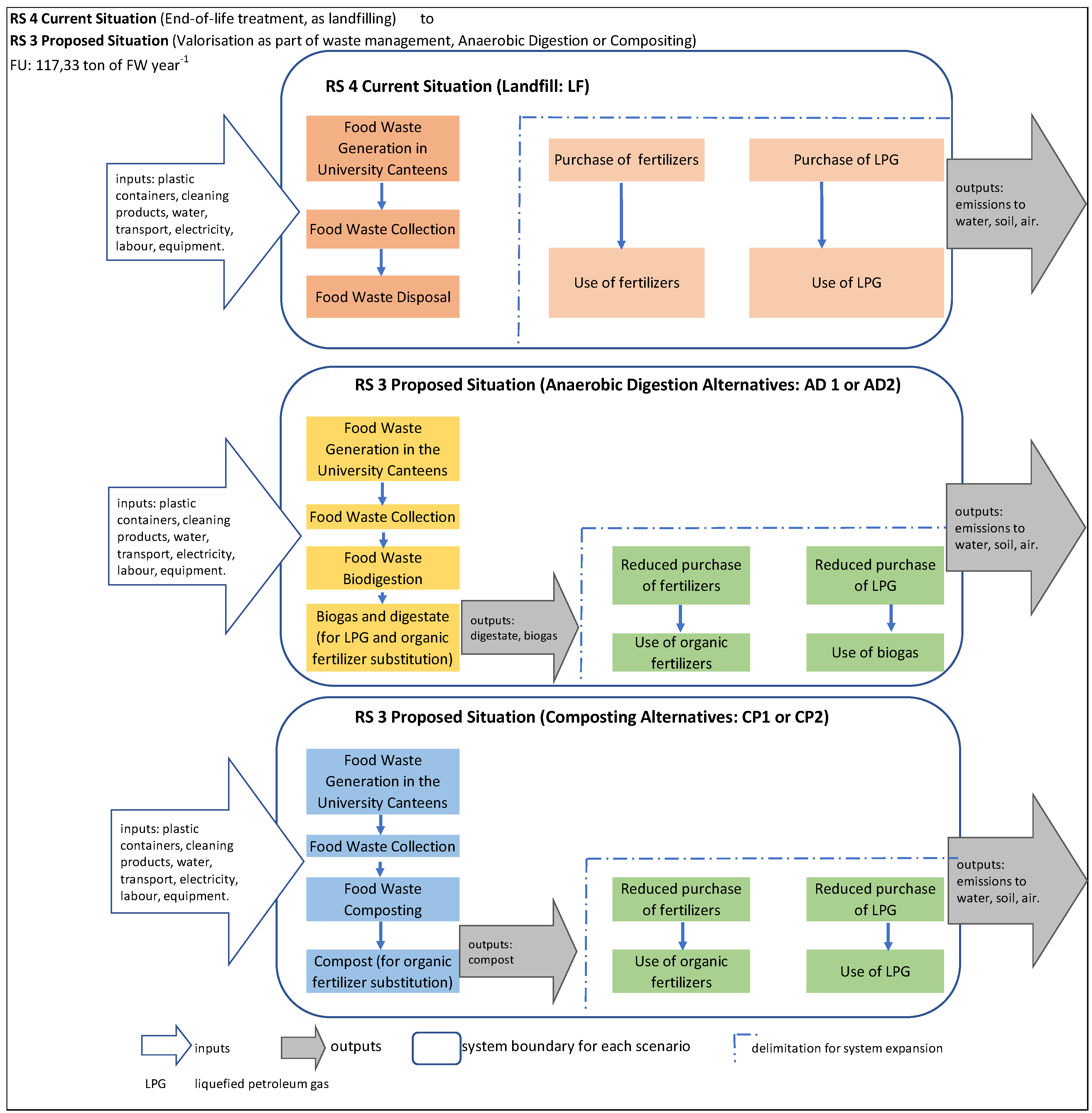
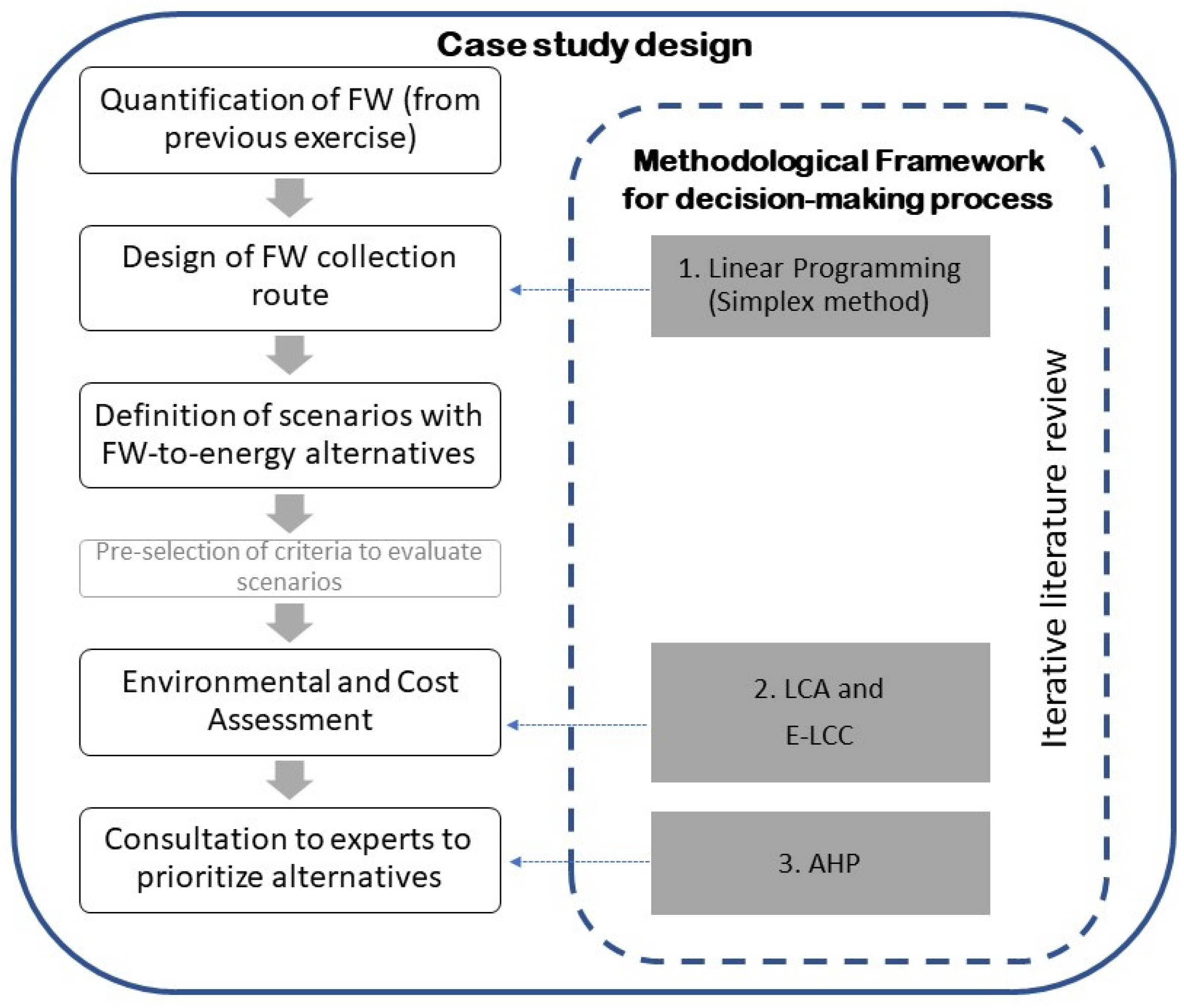

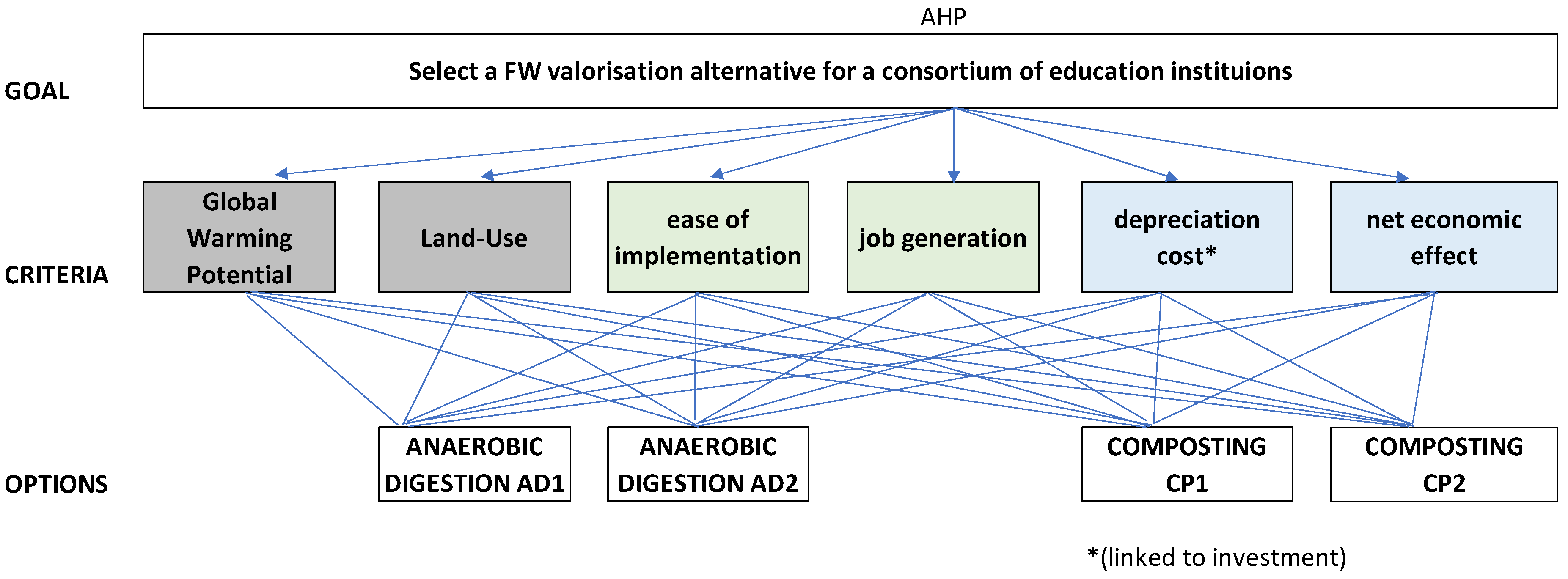
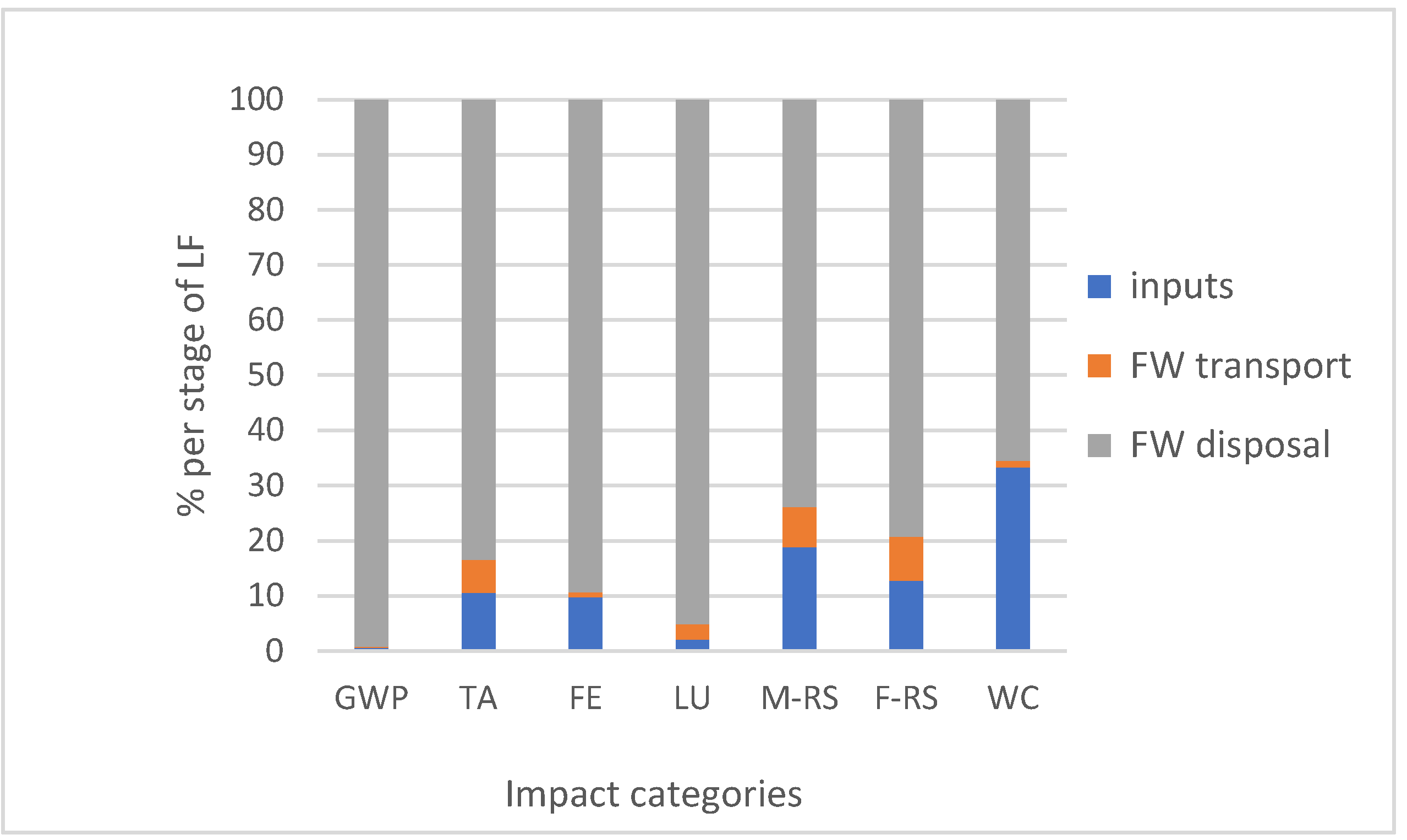
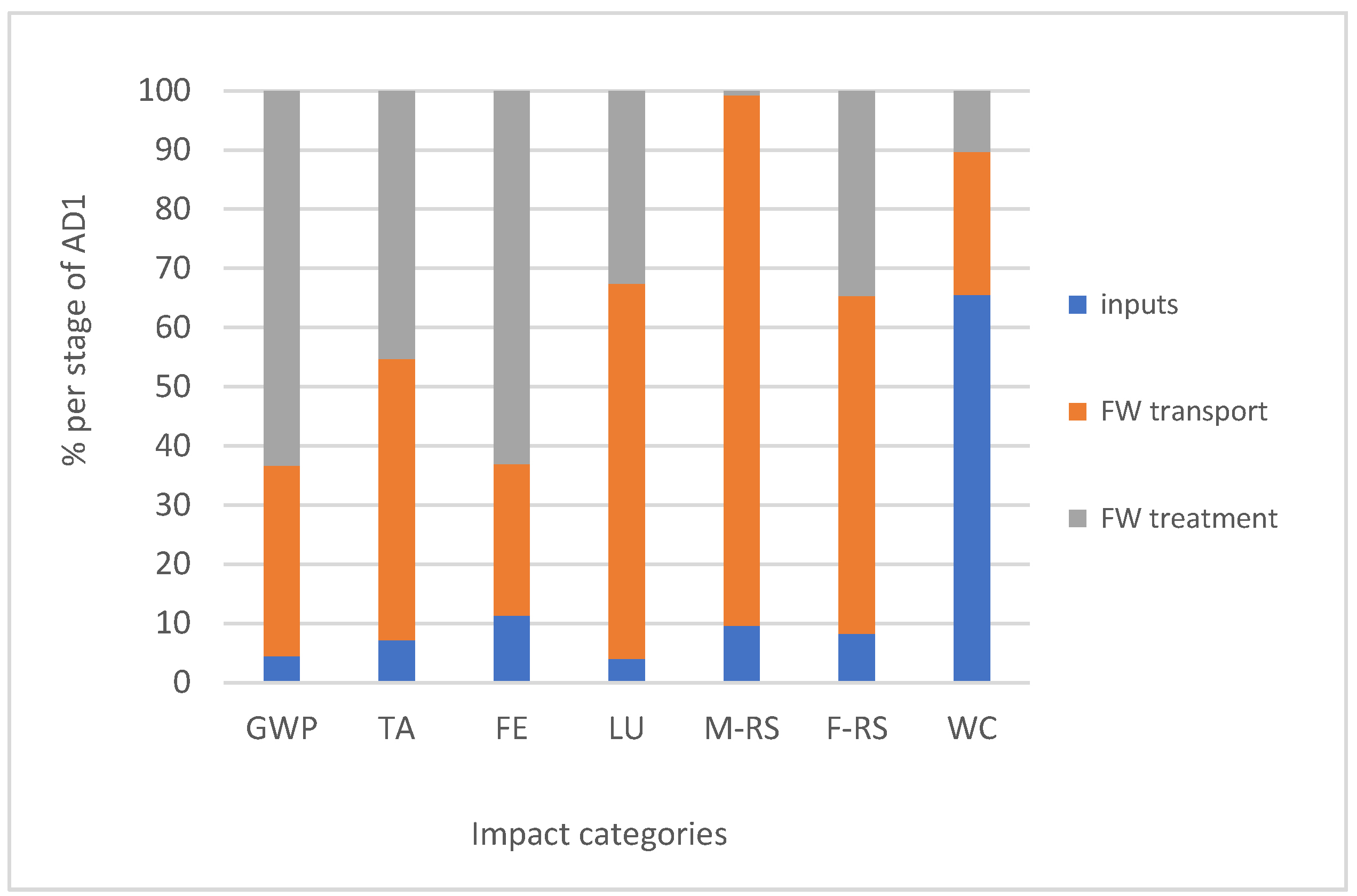
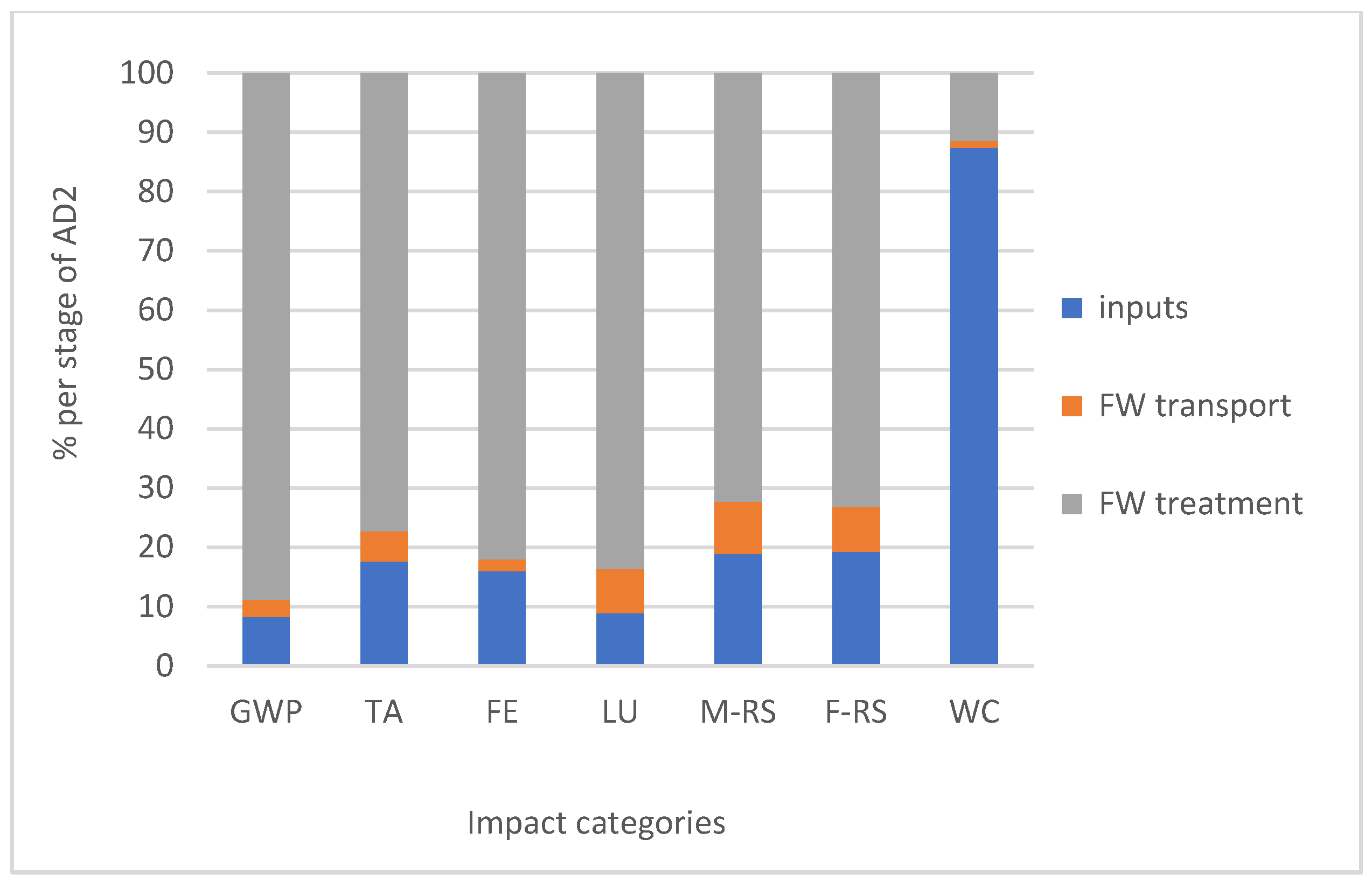
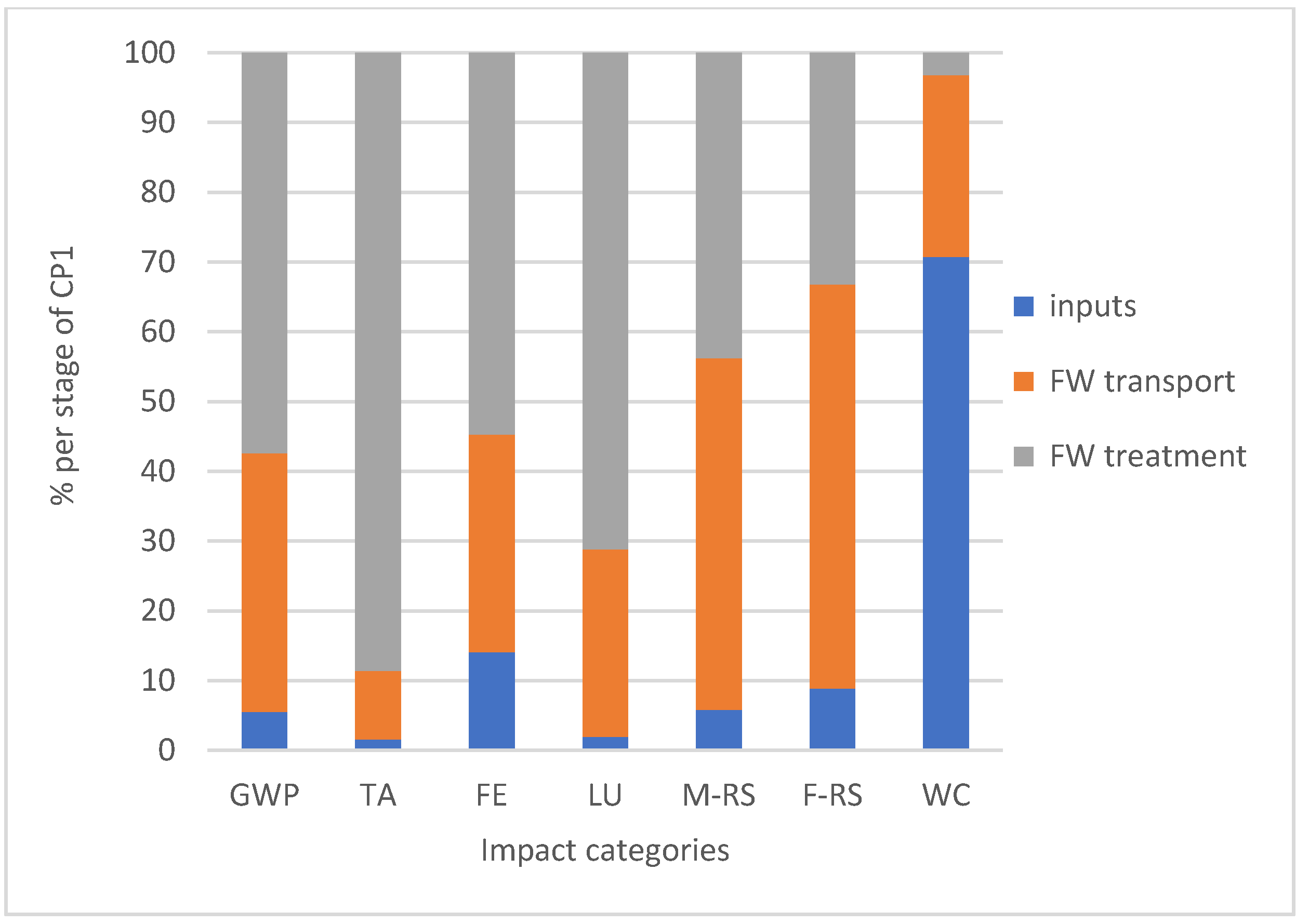
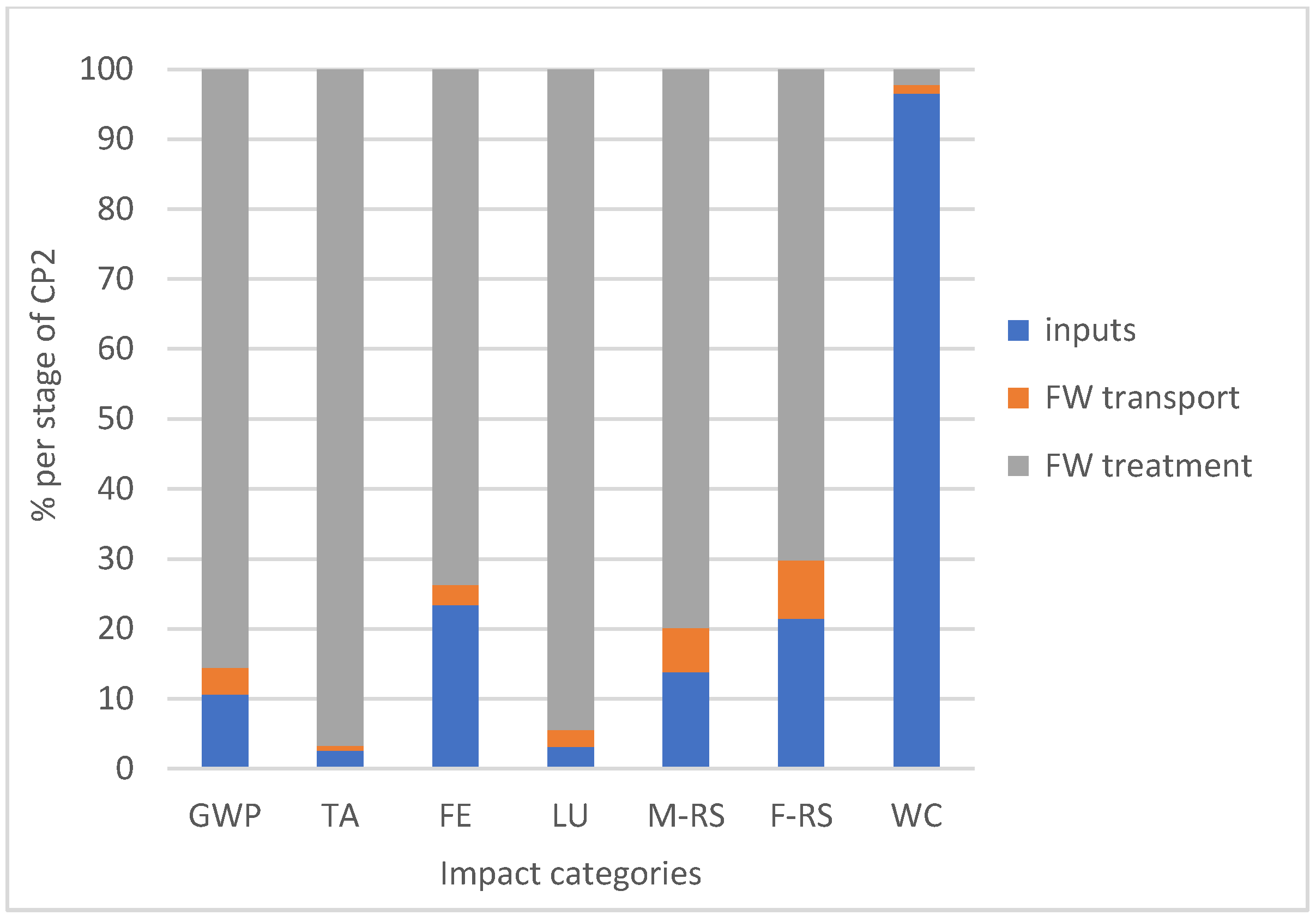
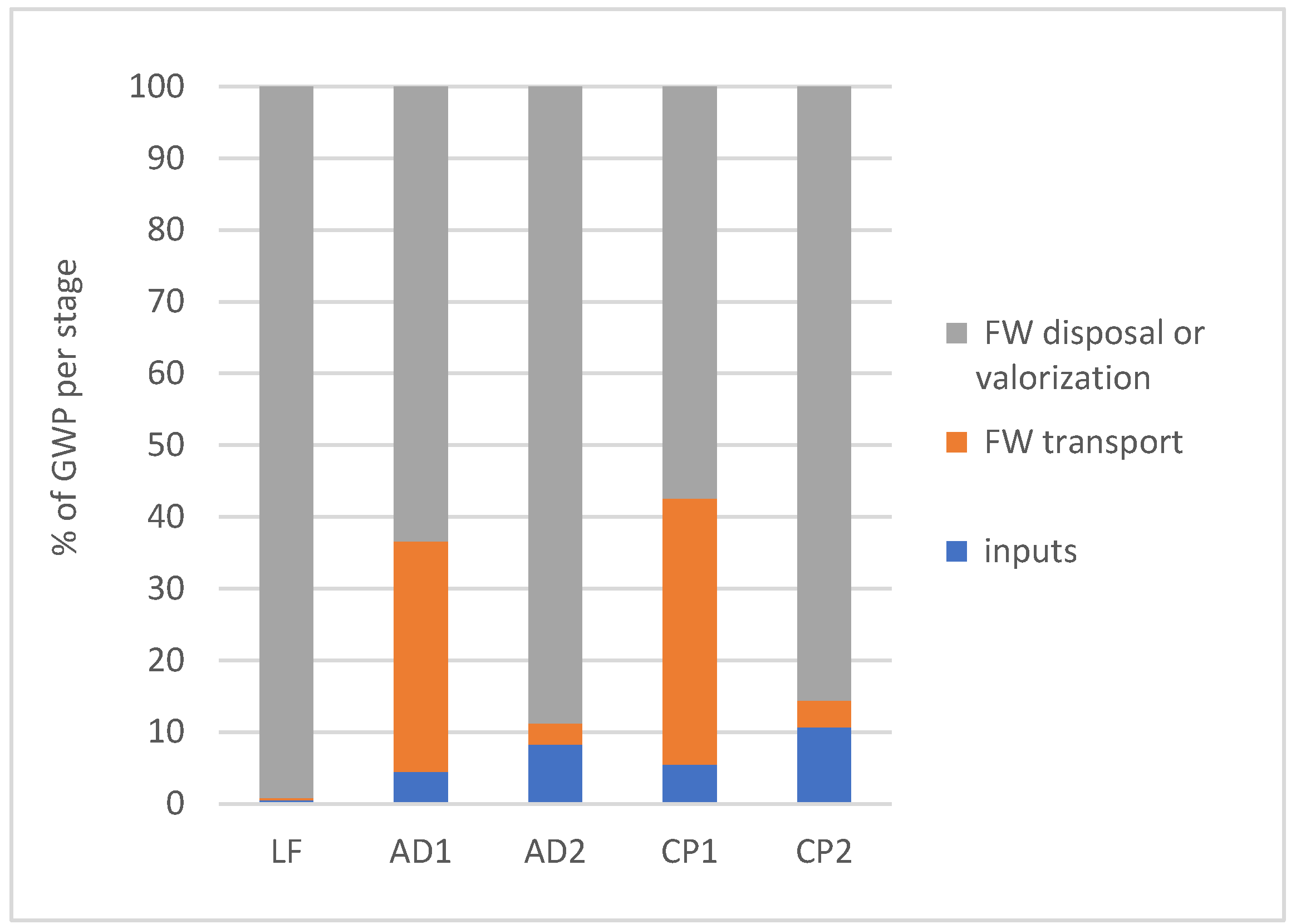
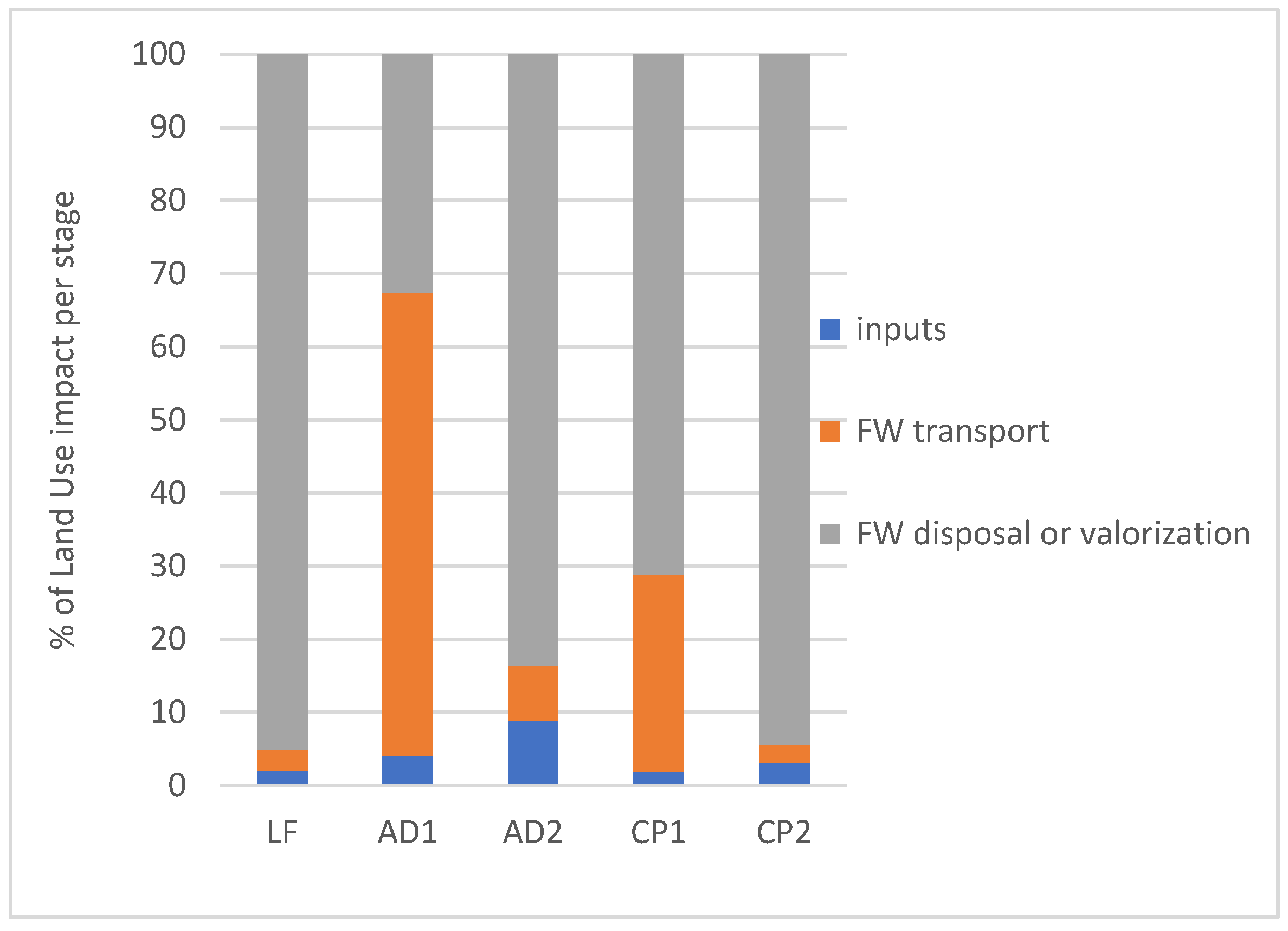
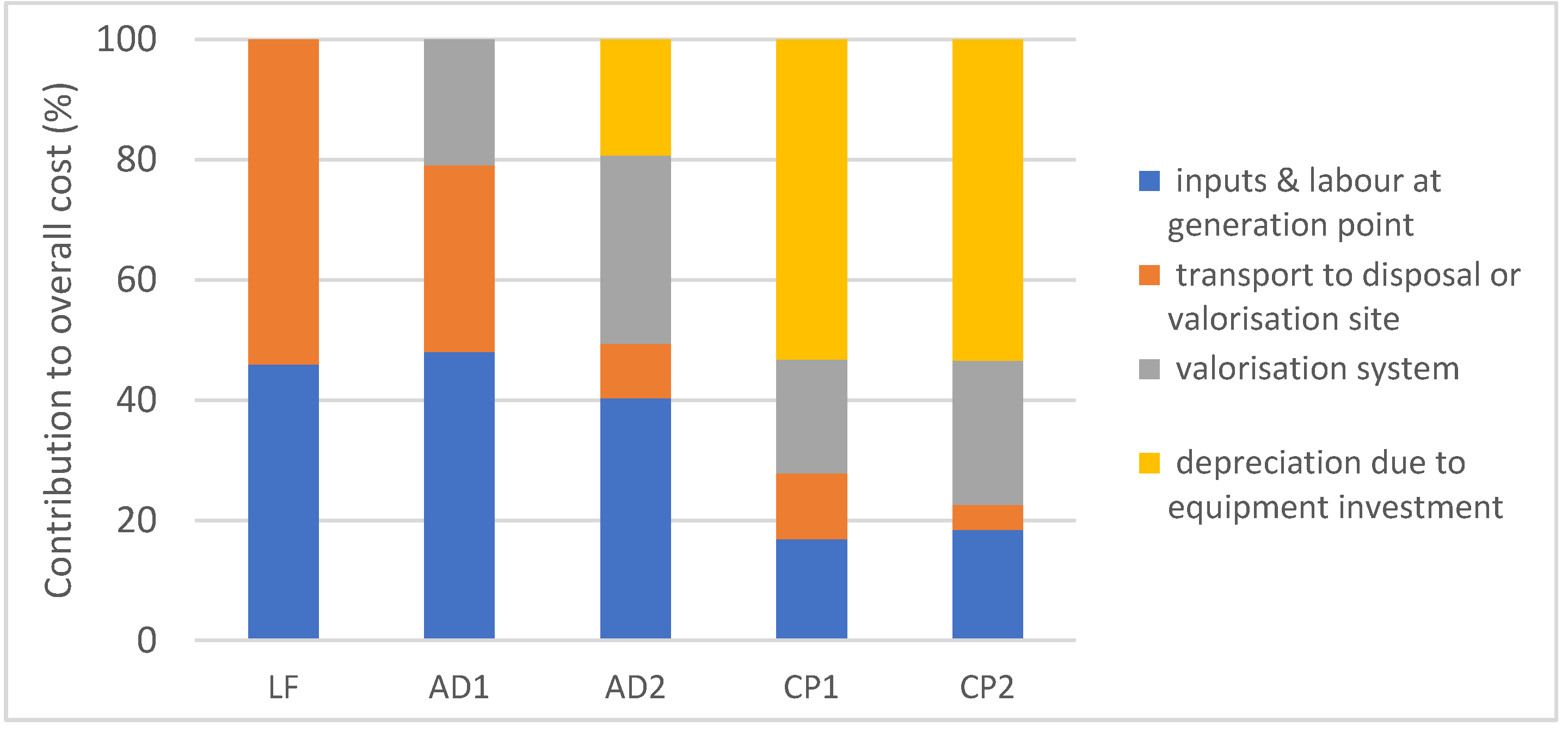
| SITES | A | B | C | D | E |
|---|---|---|---|---|---|
| A | 0 | 22 | 40 | 34 | 104 |
| B | 22 | 0 | 16 | 11 | 86 |
| C | 40 | 16 | 0 | 11 | 82 |
| D | 34 | 11 | 11 | 0 | 95 |
| E | 104 | 86 | 82 | 95 | 0 |
| SITES | A | B | C | D |
|---|---|---|---|---|
| A | 0 | 22 | 40 | 34 |
| B | 22 | 0 | 16 | 11 |
| C | 40 | 16 | 0 | 11 |
| D | 34 | 11 | 11 | 0 |
| Site | Available Space | Technical Capacity | Available Infrastructure | FW Quantity | Score |
|---|---|---|---|---|---|
| A | 25 | 15 | 0 | 25 | 65 |
| B | 0 | 15 | 0 | 5 | 20 |
| C | 25 | 15 | 35 | 15 | 90 |
| D | 0 | 15 | 0 | 10 | 25 |
| E | 25 | 15 | 35 | 20 | 95 |
| Impact Category | Unit | LF | AD1 | AD2 | CP1 | CP2 |
|---|---|---|---|---|---|---|
| Global Warming | kg CO2 eq | 90,050.00 | 16,113.16 | 11,906.42 | 13,973.26 | 9376.31 |
| Terrestrial Acidification | kg SO2 eq | 17.01 | 40.11 | 25.45 | 193.92 | 177.66 |
| Freshwater Eutrophication | kg P eq | 2.23 | 2.20 | 1.92 | 1.80 | 1.34 |
| Land Use | m2a crop eq | 388.48 | 230.30 | 132.64 | 542.52 | 408.88 |
| Mineral Resource Scarcity | kg Cu eq | 6.84 | 16.80 | 11.68 | 29.92 | 16.41 |
| Fossil Resource Scarcit | kg oil eq | 1140.30 | 3034.22 | 1553.35 | 2992.81 | 1417.40 |
| Water Consumption | m3 | 58.22 | 59.74 | 88.57 | 55.53 | 80.32 |
| Cost Category | LF | AD1 | AD2 | CP1 | CP2 |
|---|---|---|---|---|---|
| Inputs and labour at generation point | 7635.32 | 7635.32 | 7635.32 | 7635.32 | 7635.32 |
| Transport to disposal or valorisation plant | 8986.26 | 4938.27 | 1709.29 | 4938.27 | 1709.29 |
| Valorisation system | - | 3334.81 | 5940.72 | 8562.19 | 9907.89 |
| Depreciation due to equipment investment | - | 3647.70 | 24,023.69 | 22,112.71 | |
| Total | 16,621.58 | 15,908.41 | 18,933.03 | 45,159.47 | 41,365.21 |
| Indicator | AD1 | AD2 | CP1 | CP2 | |
|---|---|---|---|---|---|
| GWP (CO2 eq) | new impact | 16,113.16 | 11,906.42 | 13,973.26 | 9376.31 |
| avoided impact | 1,260,078.39 | 1,219,486.49 | 91,012.29 | 90,050.00 | |
| net effect | −1,243,965.24 | −1,207,580.07 | −7039.03 | −80,673.69 | |
| LU (m2a crop eq) | new impact | 230.30 | 132.64 | 542.53 | 408.88 |
| avoided impact | 13,391.95 | 12,248.63 | 417.27 | 388.48 | |
| net effect | −13,161.65 | −12,115.99 | 125.26 | 20.40 | |
| Net Economic effect (USD) | new cost | 15,908.41 | 18,933.03 | 45,159.47 | 41,365.21 |
| avoided cost | 729,659.58 | 729,05.66 | 19,985.77 | 20,016.95 | |
| Net cost effect | −713,751.18 | −710,772.63 | 25,173.70 | 21,348.26 |
| Indicator | Global Warming Potential | Land-Use | Ease of Implementation | Job Generation | Depreciation Cost | Net Economic Effect | Priority Vector |
|---|---|---|---|---|---|---|---|
| Global Warming Potential | 0.130 | 0.136 | 0.194 | 0.115 | 0.124 | 0.120 | 0.136 |
| Land-Use | 0.235 | 0.245 | 0.152 | 0.313 | 0.239 | 0.221 | 0.234 |
| Ease of implementation | 0.057 | 0.138 | 0.085 | 0.071 | 0.087 | 0.095 | 0.089 |
| Job generation | 0.306 | 0.212 | 0.327 | 0.271 | 0.301 | 0.297 | 0.286 |
| Depreciation cost | 0.178 | 0.173 | 0.165 | 0.152 | 0.169 | 0.181 | 0.170 |
| Net economic effect | 0.093 | 0.095 | 0.077 | 0.078 | 0.080 | 0.086 | 0.085 |
| CR = 0.01 < 0.10 | |||||||
| Global Warming Potential | Land-Use | |||||||||||
|---|---|---|---|---|---|---|---|---|---|---|---|---|
| AD1 | AD2 | CP1 | CP2 | priority vector | AD1 | AD2 | CP1 | CP2 | priority vector | |||
| AD1 | 0.201 | 0.278 | 0.204 | 0.163 | 0.211 | AD1 | 0.266 | 0.391 | 0.255 | 0.176 | 0.272 | |
| AD2 | 0.107 | 0.149 | 0.166 | 0.169 | 0.148 | AD2 | 0.108 | 0.159 | 0.285 | 0.110 | 0.166 | |
| CP1 | 0.405 | 0.368 | 0.411 | 0.435 | 0.405 | CP1 | 0.360 | 0.194 | 0.346 | 0.538 | 0.360 | |
| CP2 | 0.287 | 0.205 | 0.220 | 0.233 | 0.236 | CP2 | 0.266 | 0.256 | 0.113 | 0.176 | 0.203 | |
| CR = 0.02 | CR = 0.09 | |||||||||||
| Ease of Implementation | Job Generation | |||||||||||
| AD1 | AD2 | CP1 | CP2 | priority vector | AD1 | AD2 | CP1 | CP2 | priority vector | |||
| AD1 | 0.257 | 0.265 | 0.335 | 0.178 | 0.259 | AD1 | 0.542 | 0.540 | 0.576 | 0.484 | 0.535 | |
| AD2 | 0.251 | 0.258 | 0.290 | 0.210 | 0.252 | AD2 | 0.187 | 0.186 | 0.179 | 0.189 | 0.185 | |
| CP1 | 0.190 | 0.220 | 0.247 | 0.402 | 0.265 | CP1 | 0.163 | 0.180 | 0.173 | 0.230 | 0.186 | |
| CP2 | 0.302 | 0.258 | 0.129 | 0.210 | 0.225 | CP2 | 0.108 | 0.094 | 0.072 | 0.096 | 0.093 | |
| CR = 0.05 | CR = 0.01 | |||||||||||
| Depreciation Cost | Net Economic Effect | |||||||||||
| AD1 | AD2 | CP1 | CP2 | priority vector | AD1 | AD2 | CP1 | CP2 | priority vector | |||
| AD1 | 0.199 | 0.110 | 0.268 | 0.208 | 0.196 | AD1 | 0.221 | 0.385 | 0.191 | 0.186 | 0.246 | |
| AD2 | 0.331 | 0.182 | 0.233 | 0.095 | 0.210 | AD2 | 0.093 | 0.161 | 0.254 | 0.156 | 0.166 | |
| CP1 | 0.246 | 0.260 | 0.332 | 0.464 | 0.325 | CP1 | 0.443 | 0.242 | 0.382 | 0.453 | 0.380 | |
| CP2 | 0.224 | 0.447 | 0.167 | 0.234 | 0.268 | CP2 | 0.243 | 0.211 | 0.173 | 0.205 | 0.208 | |
| CR = 0.10 | CR = 0.06 | |||||||||||
| Global Warming Potential | Land-Use | Ease of Implementation | Job Generation | Depreciation Cost | Net Economic Effect | Prioritization | Ranking | |
|---|---|---|---|---|---|---|---|---|
| (priority vector) | (0.136) | (0.234) | (0.089) | (0.286) | (0.170) | (0.085) | ||
| AD1 | 0.029 | 0.064 | 0.023 | 0.153 | 0.033 | 0.021 | 0.323 | 1 |
| AD2 | 0.020 | 0.039 | 0.022 | 0.053 | 0.036 | 0.014 | 0.184 | 4 |
| CP1 | 0.055 | 0.084 | 0.024 | 0.053 | 0.055 | 0.032 | 0.304 | 2 |
| CP2 | 0.032 | 0.048 | 0.020 | 0.026 | 0.046 | 0.018 | 0.189 | 3 |
© 2020 by the authors. Licensee MDPI, Basel, Switzerland. This article is an open access article distributed under the terms and conditions of the Creative Commons Attribution (CC BY) license (http://creativecommons.org/licenses/by/4.0/).
Share and Cite
Brenes-Peralta, L.; Jiménez-Morales, M.F.; Campos-Rodríguez, R.; De Menna, F.; Vittuari, M. Decision-Making Process in the Circular Economy: A Case Study on University Food Waste-to-Energy Actions in Latin America. Energies 2020, 13, 2291. https://doi.org/10.3390/en13092291
Brenes-Peralta L, Jiménez-Morales MF, Campos-Rodríguez R, De Menna F, Vittuari M. Decision-Making Process in the Circular Economy: A Case Study on University Food Waste-to-Energy Actions in Latin America. Energies. 2020; 13(9):2291. https://doi.org/10.3390/en13092291
Chicago/Turabian StyleBrenes-Peralta, Laura, María F. Jiménez-Morales, Rooel Campos-Rodríguez, Fabio De Menna, and Matteo Vittuari. 2020. "Decision-Making Process in the Circular Economy: A Case Study on University Food Waste-to-Energy Actions in Latin America" Energies 13, no. 9: 2291. https://doi.org/10.3390/en13092291
APA StyleBrenes-Peralta, L., Jiménez-Morales, M. F., Campos-Rodríguez, R., De Menna, F., & Vittuari, M. (2020). Decision-Making Process in the Circular Economy: A Case Study on University Food Waste-to-Energy Actions in Latin America. Energies, 13(9), 2291. https://doi.org/10.3390/en13092291






